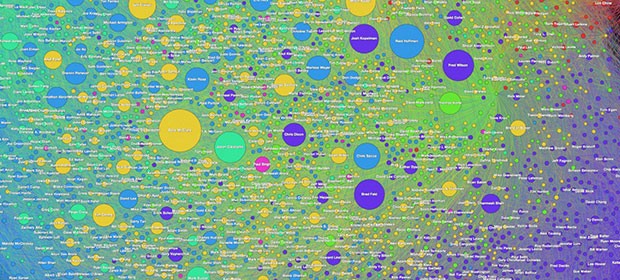Tim O'Reilly
Improving Uber’s surge pricing
Should algorithmic pricing be the norm rather than the exception?

Request an invitation to Next:Economy, our event aiming to shed light on the transformation in the nature of work now being driven by algorithms, big data, robotics, and the on-demand economy.
Companies want a bigger share of the pie than their competitors, capital wants a bigger share than labor (and labor wants right back), countries want a bigger share than their rivals, but true wealth comes when we make a bigger pie for everyone. Well run markets are a proven way to do that.
Surge pricing is one of Uber’s most interesting labor innovations. Faced with the problem that they don’t have enough drivers in particular neighborhoods or at particular hours, they use market mechanisms to bring more drivers to those areas. If they need more drivers, they raise the price to consumers until enough drivers are incented by the possibility of higher earnings to fill the demand. Pricing is not set arbitrarily. It is driven algorithmically by pickup time — the goal is to have enough cars on the road that a passenger will get a car within 3–5 minutes. (Lyft’s Prime Time pricing is a similar system.) Uber keeps raising the price until the pickup time falls into the desired range.
This is clearly an imperfect system. In one case, surge pricing gouged customers during a crisis, and even in more prosaic situations like bad weather, the end of a sporting event, or a holiday evening, customers can see enormous price hikes. This uncertainty undercuts the fundamental promise of the app, of cheap, on-demand transportation. If you don’t know how much the ride will cost, can you rely on it?
A world of continous partial employment
Managers and workers benefit when both have access to data and control.

Request an invitation to Next:Economy, our event aiming to shed light on the transformation in the nature of work now being driven by algorithms, big data, robotics, and the on-demand economy.
Our future workplaces are increasingly managed by apps and algorithms. Is technology empowering workers, or making them ever more helpless cogs in a corporate profit machine?
When we talk about the “on-demand economy,” we are really talking about two things: the ability of a consumer to summon a vehicle, their lunch, or their groceries with the touch of an app or a few words to Siri, Cortana, or Google Now; and the lives of the workers who respond to those summons. Instant on-demand consumer services mean workers must also be available on demand.
As Logan Green of Lyft noted, his company provides “transportation as a service.” Perhaps the more general point is that it provides labor as a service. At least for now, the car comes with a driver.
Companies such as Lyft, Uber, TaskRabbit, Postmates, Upwork (and too many other new startups to count) all depend on a large pool of workers who make no set work commitments, who are bound to no schedule, but simply turn on an app when they want to work, and compete with other workers for whatever jobs are available.
These apps have gotten a lot of attention. But focusing that attention merely on “Next Economy companies” misses many of the deeper changes in the labor economy.
The rise of networked platforms for physical world services
A look at the huge economic shift led by software and connectedness.

Request an invitation to Next:Economy, our event aiming to shed light on the transformation in the nature of work now being driven by algorithms, big data, robotics, and the on-demand economy.
One of the themes we’re exploring at the Next:Economy summit is the way that networks trump traditional forms of corporate organization, and how they are changing traditional ways of managing that organization. Uber and Airbnb are textbook examples of this trend. Uber has ambitious plans to manage hundreds of thousands — eventually even millions — of independent drivers with a small core of employees building a technology platform that manages those workers. Airbnb is on track to have more rooms on offer than large hotel chains, with under a thousand employees.
Esko Kilpi beautifully described the power of networks in an essay on Medium, The Future of Firms, reflecting on economist Ronald Coase’s theory of 20th century business organization. He wrote:
The existence of high transaction costs outside firms led to the emergence of the firm as we know it, and management as we know it. … The reverse side of Coase’s argument is as important: if the (transaction) costs of exchanging value in the society at large go down drastically, as is happening today, the form and logic of economic and organizational entities necessarily need to change! The core firm should now be small and agile, with a large network.
The mainstream firm, as we have known it, becomes the more expensive alternative. This is something that Ronald Coase did not see coming. Accordingly, a very different kind of management is needed when coordination can be performed without intermediaries with the help of new technologies. Apps can do now what managers used to do.[Bolding mine.]
Today, we stand on the threshold of an economy where the familiar economic entities are becoming increasingly irrelevant. The Internet and new Internet-based firms, rather than the traditional organizations, are becoming the most efficient means to create and exchange value.
The WTF economy is transforming how we do business
Our Next:Economy event aims to inspire industry leaders to rebuild the economy by solving the hard problems.
Request an invitation to Next:Economy, our event aiming to shed light on the transformation in the nature of work now being driven by algorithms, big data, robotics, and the on-demand economy.
WTF?! In San Francisco, Uber has 3x the revenue of the entire prior taxi and limousine industry.
WTF?! Without owning a single room, Airbnb has more rooms on offer than some of the largest hotel groups in the world. Airbnb has 800 employees, while Hilton has 152,000.
WTF?! Top Kickstarters raise tens of millions of dollars from tens of thousands of individual backers, amounts of capital that once required top-tier investment firms.
WTF?! What happens to all those Uber drivers when the cars start driving themselves? AIs are flying planes, driving cars, advising doctors on the best treatments, writing sports and financial news, and telling us all, in real time, the fastest way to get to work. They are also telling human workers when to show up and when to go home, based on real-time measurement of demand.The algorithm is the new shift boss.
WTF?! A fabled union organizer gives up on collective bargaining and instead teams up with a successful high tech entrepreneur and investor togo straight to the people with a local $15 minimum wage initiative that is soon copied around the country, outflanking a gridlocked political establishment in Washington.
What do on-demand services, AI, and the $15 minimum wage movement have in common? They are telling us, loud and clear, that we’re in for massive changes in work, business, and the economy.
Rethinking and redesigning at beta.oreilly.com
O’Reilly’s new beta site puts the focus on learning and ideas.
Some while back, we realized that O’Reilly is really in the education business — very specifically, the self-education and self-improvement business. People read our books, come to our events, and watch our videos because they need new skills and have the discipline and initiative to seek them out on their own. In a lot of ways, the history of the company has been searching out new ways to achieve the same goal, which 15 years ago I articulated as “changing the world by spreading the knowledge of innovators.”
That goal requires us to notice the ideas and technologies that are new and important; to find the people who have figured out how to make the most of those technologies; and of the people who’ve figured it out, to discover who has the willingness and the ability to invest in helping others to follow in their footsteps. Over time, pursuit of our goal has also required us to learn how to write, edit, publish, and distribute books; to run events that bring people together to learn from each other; and (more recently), to develop video training courses and other online learning products.
We aren’t the only ones who’ve noticed that O’Reilly is a learning company. I was delighted to see oreilly.com chosen as the #1 online course provider, ahead of MOOCs, video training companies, and others who explicitly position themselves as training providers. I like to think that the breadth of ways that we give people to learn — print, video, in-person, and interactive online — is unique because it doesn’t restrict itself to people who have one single learning style.
All of this is by way of explaining the redesign that we’re rolling out at beta.oreilly.com. Over the years, we’d let oreilly.com become mostly a front end for ecommerce, selling access to books and videos and conference seats, with a dose of reporting and advocacy on the side. Read more…
#SocialCivics and the architecture of participation
As you rethink civic participation, think about standardized parts and the unit size for participation.
 It was big news recently that former Twitter executive Jason Goldman is joining the White House to head up a new office of Digital Strategy.
It was big news recently that former Twitter executive Jason Goldman is joining the White House to head up a new office of Digital Strategy.
In his post, Jason asked for advice, posted anywhere, using the hashtag #socialcivics. I decided to do a writeup, as he asked, to share my ideas and to spark further conversation.
Briefly, Jason’s mission, on behalf of the White House, is to create new tools and processes for civic engagement, so that all of us are working more effectively together to build a nation that works for everyone, not just for the few with privileged access.
One of the key ideas I have to offer is something that years ago, in the context of open source software, I called “the architecture of participation.” I wrote:
[Open source software projects] that have built large development communities have done so because they have a modular architecture that allows easy participation by independent or loosely coordinated developers … The Web, however, took the idea of participation to a new level because it opened that participation not just to software developers, but to all users of the system.
Open data for open lands
Recreation.gov should be a platform, not a silo.
President Obama’s well-publicized national open data policy (pdf) makes it clear that government data is a valuable public resource for which the government should be making efforts to maximize access and use. This policy was based on lessons from previous government open data success stories, such as weather data and GPS, which form the basis for countless commercial services that we take for granted today and that deliver enormous value to society. (You can see an impressive list of companies reliant on open government data via GovLab’s Open Data 500 project.)
Based on this open data policy, I’ve been encouraging entrepreneurs to invest their time and ingenuity to explore entrepreneurial opportunities based on government data. I’ve even invested (through O’Reilly AlphaTech Ventures) in one such start-up, Hipcamp, which provides user-friendly interfaces to making reservations at national and state parks.
A better system is sorely needed. The current reservation system is clunky and difficult to use. Hipcamp changes all that, making it a breeze to reserve camping spots. Read more…
What Amazon, iTunes, and Uber teach us about Apple Pay
Truly disruptive services don’t just digitize the familiar. They do away with it.
 Something’s been nagging at me about Apple Pay, and the hype about it.
Something’s been nagging at me about Apple Pay, and the hype about it.
The Apple-Pay web page gushes: “Gone are the days of searching for your wallet. The wasted moments finding the right card. The swiping and waiting. Now payments happen with a single touch.”
What’s wrong with this picture?
It’s describing the digital facsimile of a process that is already on its way to becoming obsolete. But truly disruptive new services don’t just digitize the familiar. They do away with it.
I never search for my wallet when I take an Uber. I never search for my wallet when I walk out of a restaurant that accepts Cover. I never search for my wallet when I buy something from Amazon. I don’t even search for my wallet when buying a song from iTunes — or, for that matter, an iPhone from an Apple Store.
In each of these cases, my payment information is simply a stored credential that is already associated with my identity. And that identity is increasingly recognized by means other than an explicit payment process. Read more…
O’Reilly purchases Pearson’s stake in Safari
Safari Books Online is now a wholly owned subsidiary of O’Reilly Media.
I’m pleased to share some exciting news. On Friday, August 1st, O’Reilly purchased Pearson Education’s 50% ownership share of our Safari Books Online joint venture, and Safari is now a wholly owned subsidiary of O’Reilly Media, Inc.
O’Reilly believes strongly in the direction Safari is heading, and we came to believe that there are substantial opportunities for both organizations working much more closely together. O’Reilly is primarily a media company (books, events, online in-person and video training, expert network), and Safari has the technology, sales, and distribution channel for bringing content to the widest audience possible, especially a B2B audience.
Going forward, O’Reilly and Safari will work together to create new features and products, but Safari will continue to operate as an independent entity, as it did when jointly owned by O’Reilly and Pearson. There are no changes in Safari’s products, staffing, offices, or operations. The Safari brand and domains remain the same, and Pearson will remain a key strategic content partner of Safari. All their current materials remain available, and their future books and videos will be added to the service. Read more…
#IoTH: The Internet of Things and Humans
The IoT requires thinking about how humans and things cooperate differently when things get smarter.
Rod Smith of IBM and I had a call the other day to prepare for our onstage conversation at O’Reilly’s upcoming Solid Conference, and I was surprised to find how much we were in agreement about one idea: so many of the most interesting applications of the Internet of Things involve new ways of thinking about how humans and things cooperate differently when the things get smarter. It really ought to be called the Internet of Things and Humans — #IoTH, not just #IoT!
Let’s start by understanding the Internet of Things as the combination of sensors, a network, and actuators. The “wow” factor — the magic that makes us call it an Internet of Things application — can come from creatively amping up the power of any of the three elements.
For example, a traditional “dumb” thermostat consists of only a sensor and an actuator — when the temperature goes out of the desired range, the heat or air conditioning goes on. The addition of a network, the ability to control your thermostat from your smartphone, say, turns it into a simple #IoT device. But that’s the bare-base case. Consider the Nest thermostat: where it stands out from the crowd of connected thermostats is that it uses a complex of sensors (temperature, moisture, light, and motion) as well as both onboard and cloud software to provide a rich and beautiful UI with a great deal more intelligence. Read more…


